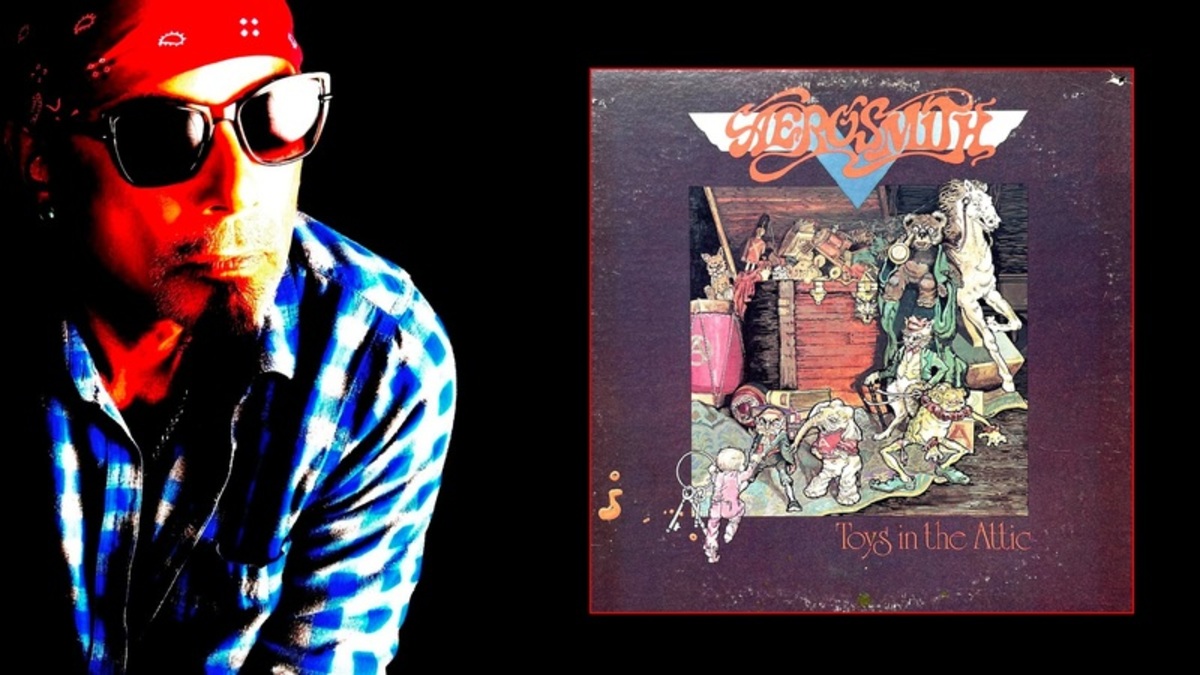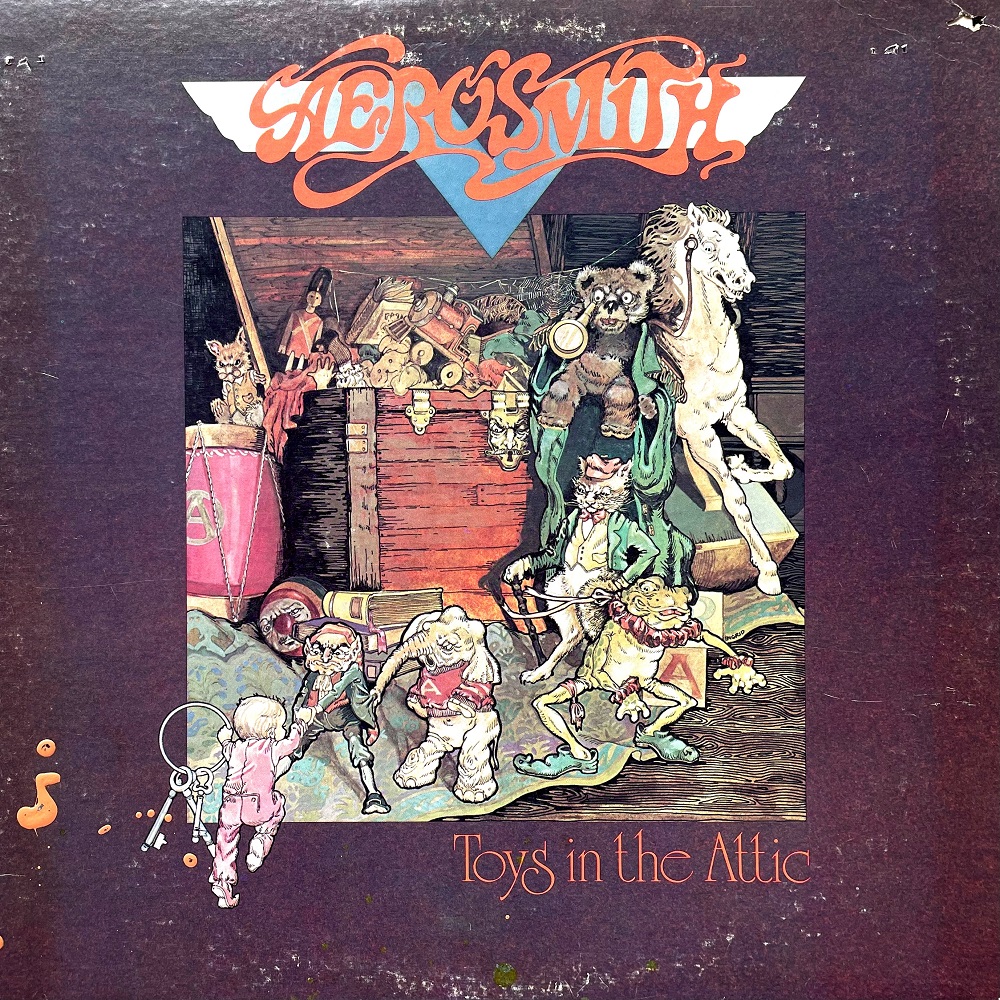
Garage Sale Vinyl: Aerosmith
Toys in the Attic / Columbia Records / April 1975
by Christopher Long
Simply put, I was in BIG trouble. In fact, the moment my mother confronted me as I came through the front door, I realized in very short order that, in the words of the late great Cuban philosopher, Ricky Ricardo, I had “a lot of esplainin’ to do!”
It was early 1977. I was just 14, and a HUGE Aerosmith fan. At that time, their single “Walk This Way” was a red-hot radio hit. As a naive church boy waiting patiently for the bowl cut to finally grow out, I thought it was the most incredible record I’d ever heard. Also, I was out of my mind in love with Andrea, the like-minded 13-year-old little rock chick from down the street. When Andrea called me up one night and asked me to write down the lyrics for her, I jumped on it, pronto. Your wish is my command, my queen!
I’ve said it before, and I’ll say it again – TIMELINE is EVERYTHING. In 1977, there was NO iPhone technology. There was NO Internet. NO Google search. NO cut and paste. As a result, I had to play my “Walk This Way” 45 rpm seven-inch single over and over at 33 1/3 rpm to decipher each and every one of Steven Tyler’s libido-soaked lyrics. “Down on a muffin?” Huh?
Honestly, I had no clue what the lyrics meant — I just thought it was a groovy tune about spirited teens. However, my mom knew exactly what “bleeder” and “muffin” meant. And assuming it was a song I’d written, she flipped out when she found the copy of my handwritten lyrics lying on the coffee table in the living room. But my prompt clarification did little to dissuade my mom’s anxieties, as she remained clearly concerned about that “garbage” I now was listening to. She further suggested that I focus more on church-related social activities. In hindsight, she was probably right.
• •
They were magical times, back when rock and roll was honest, pure, and unapologetic. In the studio, the music was created by humans who played instruments and used their actual voices to sing – songs. They used microphones and recorded these organic sounds onto reels of two-inch, multi-track analog tape. It’s a bit farfetched to fathom now, but back then, that kinda thing happened.
It was during that magical period when five boys from Beantown began brewing their unique blend of blues-injected rock. While their first two records met with only marginal initial chart success, Aerosmith was about to blow up worldwide when they dropped a doozie in 1975. Overseen by veteran producer, Jack Douglas, their multi-platinum-selling third studio set, Toys in the Attic has since become something of a self-contained “best of” collection.

The fact is, LPs DO sound better than CDs. The format, especially the records created during the glorious analog era, also is totally superior to current streaming options. And there are few mightier hard rock examples of vinyl superiority than those early Aerosmith releases — records that tragically are castrated sonically in the digital format.
Filed in among the eclectic selections contained in my GF’s modest new millennium record collection were several LPs left behind years ago by one of her former friends — including an abused original vinyl pressing of Toys in the Attic. Upon making this wonderful discovery, I pulled the scuffed record from its tattered cover, gave it a much-needed cleaning, placed it gently onto the turntable and then dropped the needle in the groove. Snap! Crackle! Pop!
Even from an old and scratchy vinyl copy, I could still feel the physical presence of Joe Perry and Brad Whitford, slashing through the speakers straight out the gate as if their Marshall amps were placed strategically between the GF’s hi-fi unit and living room sofa — right next to her recently refurbished, once-resin-coated thrift store coffee table.
As any sound-minded aficionado can attest, the true secret weapon, the key component to the signature Aerosmith swagger is bassist Tom Hamilton. Go ahead, cue up the title track. Around the 1:30 mark, you can feel the urgency building. Heartrate revving! Then, at 1:44, everything goes haywire. But beneath the frenzied ensuing guitar soloing is the track’s real payoff: that beautifully brutal Tom Hamilton bassline. And he does that kinda thing — forcing the other fellas into the backseat, again and again throughout the record.
“Uncle Salty” still provides a sultry yin to the title track’s raucous yang, while the dirty, sexy-feeling riffs of ringleader Tyler’s “Adam’s Apple” continue to speak effectively to one’s nether region. Oddly, the aforementioned hot and horny “Walk This Way” wouldn’t find life as a single for a year and a half, nearly six months following the release of the band’s next album, Rocks.
Known for its bold, double-entendre lyrics, the boogie-woogiein’, “Big Ten Inch Record” had been endeared to many since first being released by Bull Moose Jackson back in the 1950s. The revamped 1975 Aerosmith edition was explained to me at the time by a friend’s older high school cheerleader sister. “You know, they aren’t talking about an actual record, right?” Joey Kramer’s powerful, funk-fueled, single-kick drum work is magnificent on this one and provides a lasting blueprint for how rock music is meant to be played.
Only a minor Top 40 hit when first released as a single in ‘75, the Tyler / Hamilton collab, “Sweet Emotion” remains one of rock’s all-time sexiest-sounding tracks. It too would enjoy tremendous success years later as a wildly popular MTV video single. This one comes across so real, you can (almost) feel the gentle spray of Tyler’s era-accepted, “mile high” spittle, as he seemingly reaches through the speakers — grasping for a stray bottle of desperately-needed penicillin. And if you listen real close, you just might even hear Tom Hamilton in the background, hocking up a monster loogie. Maybe.
A personal favorite, the Tyler and Perry-penned “No More No More” pins crisp acoustic guitar cords to nasty, electrified riffs as Tyler wrestles lyrically with the realities of rock stardom. The twinkling piano work makes this one sparkle like a diamond, while Tyler and Whitford’s “Round and Round” drives into a dizzying, darker direction.
All of the glorious, unabashed cock rock clatter comes to a compelling conclusion with the piano-driven power ballad, “You See Me Crying.” A heart-stopping piece of work owning soaring orchestration, this shiny album highlight was cut long before power ballads were a thing. TIMELINE is EVERYTHING, you know.
In sum, Toys in the Attic arrived during a drastically different era. Decades later, it refuses to apologize for its honesty and purity, or for anything else. Nor should it. And it still stands proudly among some of rock’s tallest classics.
(5/5) ⭐⭐⭐⭐⭐

Toys in the Attic Track listing
SIDE ONE
- Toys in the Attic (Tyler, Perry) 3:05
- Uncle Salty (Tyler, Hamilton) 4:10
- Adam’s Apple (Tyler) 4:34
- Walk This Way (Tyler, Perry) 3:40
- Big Ten Inch Record (Weismantel) 2:16
SIDE TWO
- Sweet Emotion (Tyler, Hamilton) 4:34
- No More No More (Tyler, Perry) 4:34
- Round and Round (Tyler, Whitford) 5:03
- You See Me Crying (Tyler, Solomon) 5:12












